ESD simulator ISO 10605 Ed.2 Test Standard
Shinyei Corporation of America is the sole authorized distributor of NoiseKen products. We offer the most direct sales of NoiseKen products available in the US.
General
Electrostatic discharges which are generated both in vehicles and while we get on and off there can be factors to cause malfunction of the electrical devices and components. Nowadays, more attention has been paid, as vehicles install more and more electronic devices and components. This Standard provides that static electricity is discharged to the electronic devices or equipment from the charged human body and tests are simulated by electrical circuit to reproduce the electric current waveform at the discharge.
In addition to procedures for the immunity tests and evaluations in state that the electronic devices or equipment work while the vehicle is driving, also, the Standard provides tests procedures to evaluate the immunity of the each module against simulated human discharges during the assembly process or in servicing.
Test Level
The following tests levels are reference. The categories are classified according to functional importance of the electronics devices/components.
Component test – Example severity levels for direct contact discharge and direct air discharge (Function performance status)
| Direct contact discharge | Direct air discharge | |||||
| Test severity level | Category 1 | Category 2 | Category 3 | Category 1 | Category 2 | Category 3 |
| Level 4 | ±8kV | ±8kV | ±15kV | ±15kV | ±15kV | ±25kV |
| Level 3 | ±6kV | ±8kV | ±8kV | ±8kV | ±8kV | ±15kV |
| Level 2 | ±4kV | ±4kV | ±6kV | ±4kV | ±6kV | ±8kV |
| Level 1 | ±2kV | ±2kV | ±4kV | ±2kV | ±2kV | ±6kV |
Component test – Example severity levels for indirect contact discharge (Function performance status)
| Direct contact discharge | |||
| Test severity level | Category 1 | Category 2 | Category 3 |
| Level 4 | ±8kV | ±15kV | ±20kV |
| Level 3 | ±6kV | ±8kV | ±15kV |
| Level 2 | ±4kV | ±4kV | ±8kV |
| Level 1 | ±2kV | ±2kV | ±4kV |
Vehicle test — Example severity levels for contact discharge and air discharge (Test points accessible only from inside vehicle)
| Contacts discharge | Air discharge | |||||
| Test severity level | Category 1 | Category 2 | Category 3 | Category 1 | Category 2 | Category 3 |
| Level 4 | ±6kV | ±8kV | ±8kV | ±8kV | ±15kV | ±15kV |
| Level 3 | ±4kV | ±4kV | ±6kV | ±6kV | ±8kV | ±8kV |
| Level 2 | ±2kV | ±2kV | ±2kV | ±4kV | ±4kV | ±6kV |
| Level 1 | - | - | - | ±2kV | ±2kV | ±4kV |
Vehicle test — Example severity levels for contact discharge and air discharge (Test points accessible only from outside vehicle)
| Contacts discharge | Air discharge | |||||
| Test severity level | Category 1 | Category 2 | Category 3 | Category 1 | Category 2 | Category 3 |
| Level 4 | ±6kV | ±8kV | ±8kV | ±15kV | ±15kV | ±25kV |
| Level 3 | ±4kV | ±6kV | ±6kV | ±8kV | ±8kV | ±15kV |
| Level 2 | ±2kV | ±4kV | ±4kV | ±4kV | ±6kV | ±8kV |
| Level 1 | - | - | ±2kV | ±2kV | ±4kV | ±6kV |
Specification of generator and verification of output waveform
SPECIFICATION OF ESD SIMULATOR
Following specification must be satisfied with the simulator for the test.
| Output voltage . Contact discharge-(kV) | 2kV~15kV |
| Output voltages - Air discharge-(kV) | 2kV~25kV |
| Output voltages accuracy (%) | ≦5% |
| Polarity | Positive and negative |
| Rise time of short circuit current in contact discharge mode(10 % to 90 %) | 0.7ns~1ns |
| Holding time | ≧5s |
| Storage capacitances(pF) | 150pF, 330pF |
| Discharge resistances(Ω) | 2kΩ, 330Ω |
CONTACT DISCHARGE MODE CURRENT SPECIFICATIONS
Following discharges characteristics should be verified.
| Typical capacitance / resistance values | Peak current / charge voltage | Current at T1 / Charge voltage | Current at T2 / Charge voltage |
| ①150pF/330Ω | 3.75A/kV ±10% | 2A/kV ±30% (t1=30ns) | 1A/kV ±30% (t2=60ns) |
| ②330pF/330Ω | 2A/kV ±30% (t1=65ns) | 1A/kV ±30% (t2=130ns) | |
| ③150pF/2kΩ | 3.75A/kV +30% -0% | 0.275A/kV±30% (t1=180ns) | 0.15A/kV±50% (t2=360ns) |
| ④330pF/2kΩ | 0.275A/kV±30% (t1=400ns) | 0.15A/kV±50% (t2=800ns) |
VERIFICATION OF OUTPUT CURRENT WAVEFORM
The waveform shall be verified with an oscilloscope whose bandwidth is 1GHz or more in a Faraday cage or with a 1.2m x 1.2m metallic board mounting an ESD current target in the center of the cage or the board. The discharge electrode (Discharge tip of the gun) shall be touched onto the target and the discharge mode shall be set at the contact discharge mode.
The discharge return cable shall be turned up the center of the length and connected to vertically 0.5m under the target on surface of the Faraday cage or board.
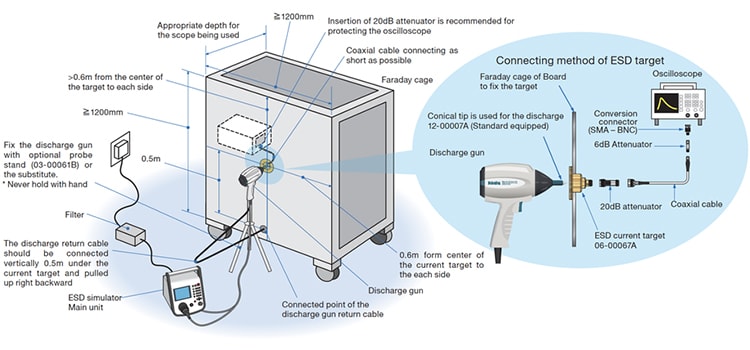
Calibration of target
Test setup and test procedure
FOR TESTING POWERED DUT IMMUNITY TO DIRECT ESD - CONTACT DISCHARGE AND AIR DISCHARGE
- Capacitance shall be selected to 150 pF (In case for components accessible from outside vehicle) or 330 pF (In case for components accessible from inside vehicle) and resistance shall be 330Ω.
- The test level shall be two or more.
- At least 3 discharges shall be applied both to the positive and negative polarities with the interval not less than 1s. The time intervals between successive single discharges in the indirect discharge shall be longer than 50 ms and the number of the test shall be >50 times.
- In the contact discharge, it shall be done to wherever human fi nger may touch.
- In the air discharge, the speed of approach should be between 0.1 m/s and 0.5 m/s and the discharge tip is held perpendicular to the surface of the DUT when possible; if not possible, an angle of at least 45° to the surface of the DUT is preferred.
- Insulating blocks shall be used for DUT which is not grounded to the chassis directly.
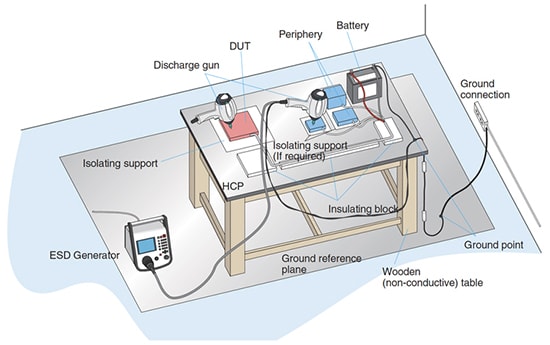
FOR TESTING POWERED DUT IMMUNITY TO INDIRECT ESD
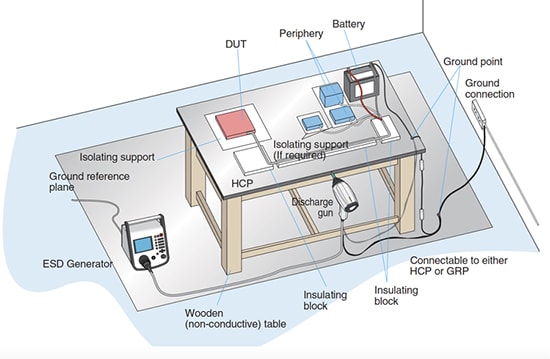
FOR TESTING (UNPOWERED) PACKAGING AND HANDLING ESD SENSITIVITY
- Capacitance shall be selected to 150 pF (Although the resistance value is not provided, it is recommended to perform the tests supposing both resistance when the DUT may be directly accessible by human body (2kΩ) and it may be accessible by a metal object a human hold (330Ω))
- The test level shall be two or more.
- At least 3 discharges shall be applied both to the positive and negative polarities with the interval not less than 1s.
- In the contact discharge, it shall be done to wherever human finger may touch.
- Charge build-up should be eliminated by briefly connecting a bleeder wire with high resistance (>1MΩ) after the discharge and the DUT shall be turned on. Afterwards, normal operation of it shall be confirmed.
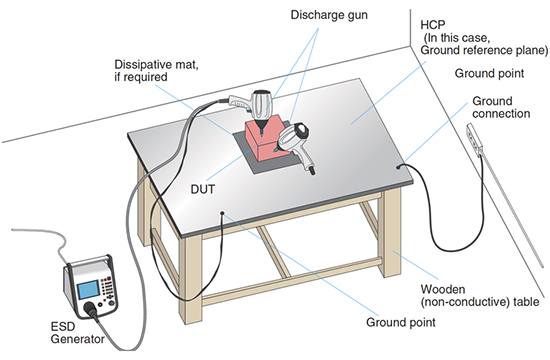
VEHICLE TEST – INTERNAL AND EXTERNAL POINTS
- Choose a generator capacitance of 330pF for areas that can easily be accessed only from the inside of the vehicle and resistance of 330Ω or 2 kΩ
- Choose a capacitance of 150 pF for points that can easily be touched only from the outside of the vehicle and resistance of 330Ω or 2 kΩ.
- The ESD generator ground shall be connected to chassis like the seat-rail in case of the interior test or connected to a metallic plate under the wheel closest to the application point in case of the exterior test.
- Both the contact discharge and air discharge shall be done both for the internal and external.
OPTIONAL TEST SET-UP AND PROCEDURE FOR ELECTRONIC MODULES (POWERED-UP TEST) – DIRECT AND INDIRECT DISCHARGE
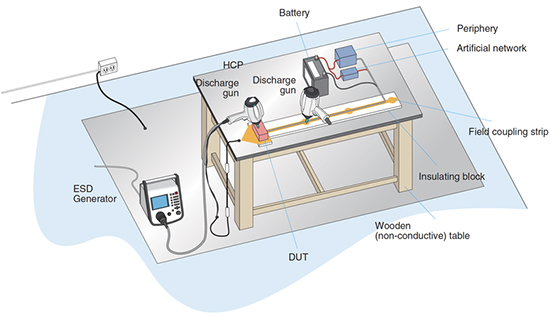
Notes : This test set-up is quoted from ISO10605 ed2.0 (2008) Standard.
Please go through the Standard if the more details are required.
Shinyei Corporation of America is the sole authorized distributor of NoiseKen products. We offer the most direct sales of NoiseKen products available in the US.







